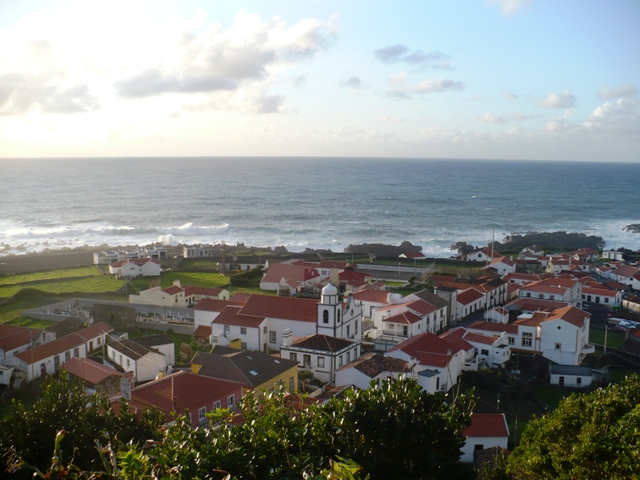Flores, the westernmost island in the Azores, is also the westernmost inhabited place in all of Europe, located 1944 km from St. John’s, Newfoundland and 1908 km from Lisbon. The island could just as easily be understood as the outer reaches of the Americas than as it currently is, as the outer extremity of Europe. A UNESCO Biosphere Reserve boasting improbably gorgeous volcanic crater lakes and horizons of summertime hydrangeas, Flores feels like a magical garden released into the middle of the Atlantic.
In February there are perhaps a dozen tourists on the island, possibly fewer. The magical garden was mine for a week.
Flores felt cool and humid in February after my long journey from London. My taxi made its way from Santa Cruz, the island’s main settlement, to Fajã Grande, a town on the island’s west coast. We climbed along a winding road through the island’s protected forest reserve. In place of hydrangeas I made do, once across the island’s central ridge, with the stunning sight of narrow ribbons of waterfalls streaming down hundreds of meters of vividly green cliffs. The scene was so Edenic that I half-expected a wizard to show up to solemnly grant me my dearest wish.
In lieu of a wizard I relied again and again on Silvio, my affable taxi driver. Silvio spent his adolescence in the Lusophone immigrant enclave of East Providence, Rhode Island, and speaks English like a New Englander. On my second morning he drove me to the village of Lajedo in the southwest. From here I set off on one of the island’s marked trails back to Fajã Grande, a distance of nine kilometers. I crossed near-overflowing streams and waterfalls, vast valleys, and farmland filled with scores of diffident cows and cranky sheep.
I saw not a single fellow walker on my excursion, though along the steepest stretch of the path into the village of Fajãzinha I intercepted a shepherd who told me where I could find a coffee. Fajãzinha’s glory may be its glorious little church, Nossa Senhora dos Remédios, dating to 1778, though the hamlet’s whitewashed houses give the church a run for its money. Here gardens overflow with flowers; these include shocks of scented narcissi. Fajãzinha’s open-air silence is deeply compelling.
The next day I walked the west coast’s northern path. I began in the northern town of Ponta Delgada and again finished up in Fajã Grande. The trail passes through moorlands and pastures bordered by low stonewalls. Every time I emerged into a new pasture rabbits scattered in every direction. More dramatic terrain followed along a narrow cliff-hugging trail that on occasion felt as if it might disappear altogether into the hillside. Vertiginous switchbacks kept me on my toes.
Later I walked down to the dark volcanic rocks where Fajã Grande drops off into the Atlantic. The waves hitting these rocks appear to regard the island as an inappropriate obstacle, and their crash can be heard hundreds of meters inland. And there I was, momentarily and rather nerdily, the westernmost person in all of Europe.
After Silvio ferried me, joyfully battered, back to Santa Cruz, I plopped down into a little restaurant. I told the waitress, also the cook, to bring me whatever she had in the kitchen. She emerged ten minutes later with a plate of five sausages, fat slices of lightly fried yam, and two fried eggs. She then brought out a big basket overflowing with yams to show off the local bounty. It was a satisfying way to end a day of simple, elemental outdoor pleasures.
Alex Robertson Textor is a London-based travel writer and editor keen on high-value independent travel, remote Europe, and beautiful little islands.
Sunvil Discovery offers tailor-made Azores itineraries to suit your interests and requirements. Take a look at our 14 day Azores Grand Tour for further inspiration.






